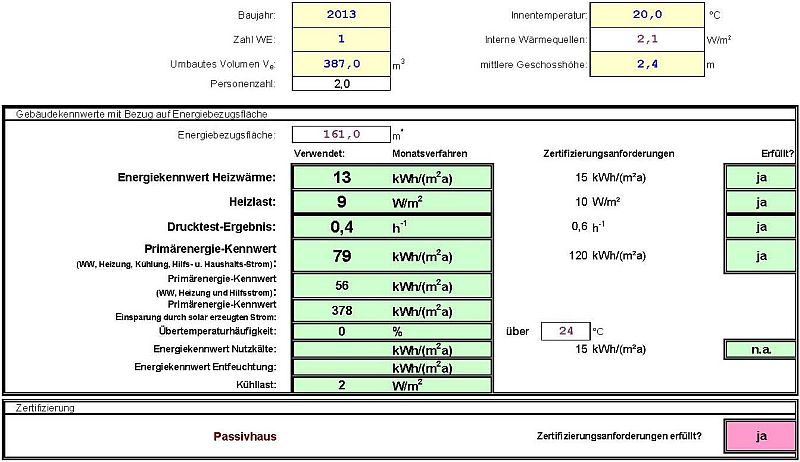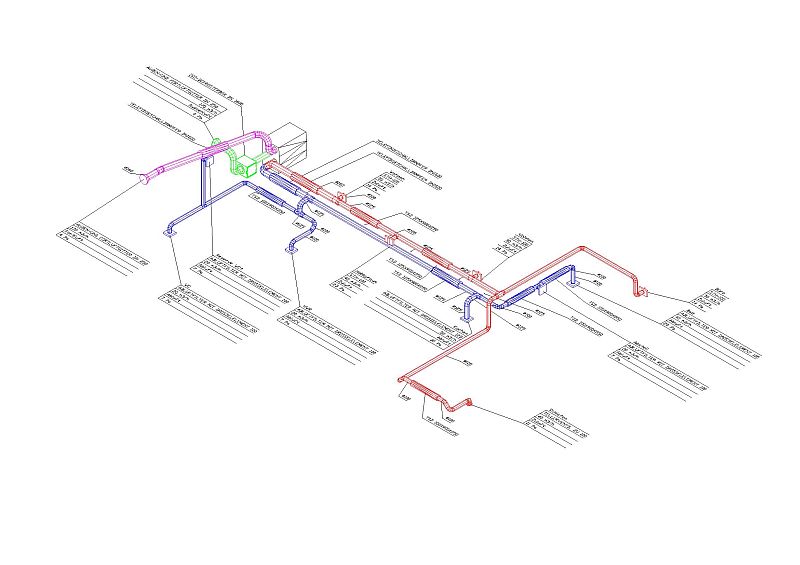|
Technical facts:
Remarks:
We saw many model homes and visited people living in their passive homes (annual days of open passive-homes) to gain detailed information about these homes and the technical equipment.
No surprise, we have could have fallen for all the latest technology (smart home, latest heat pumps, Solarthermics...)
Despite the enthusiasm – the chosen product/solution should pay off within an appropriate time frame!
While doing the research/planning for our project (in 2011/2012), we came to the conclusions listed below. We are not claiming to build better, more ecological or more modern, but only to apply a little “common sense” to our decisions.
Data:
- Useful area 161 m²
- Volume 387 m³
- U-values:
Windows (3-layer insulation glazing) 0,6 W/m²K
Base plate 0,096 W/m²K
Wall 0,096 W/m²K
Roof 0,094 W/m²K
Door (main entrance) 0,49 W/m²K
- Heating load for building – PHPP calculation 8,8 W/m² x 161 m² = 1417 Watt
- Expected power consumption for our home (guess) ~ 6 500 KWh
- Expected power production from our solar panels ~ 36 000 KWh
- We are talking about an energy-plus house by Wikipedia definition!
Electrics:
Installing common electricity in a small home costs about 3000 €, while realizing a fully equipped „smart-home“ can end up at 30 000€. I guess most builders will not spend ten times the amount for a smart-home, considering that the excess cost will never pay off in a lifetime. Additionally, one could question if the chosen system will be serviceable 25 years from now…
Conclusion for us:
Our home will have a common (+) installation, beside a few affordable conveniences (door cam, controlled shutters, Fritz Dect 200,...). Although we will install an additional distribution box (beside the breaker panel) in order to keep our options for later smart-home equipment open.
Solar Power 35 KW peak:
Based on our positive experience in planning, building and operation form our first solar-power installation (2008), we ordered our new system from Photovoltaik-Profis again.
Our lean-to roof provides a maximized solar-power area heading south. The roof pitch chosen with 10° is not perfect, but we do not need more space created by a steeper roof.
The 35 KWp system was connected to the grid in Sept 2012 and is compensated as follows:
- 0 bis 10 KWp zu 100 %
- 10 bis 35 KWp zu 90 % (lower rate)
- 10 bis 35 KWp zu 10 % (without any compensation)
We will try to reach a high percentage of self-produced power – especially for the a.m. 10 % (appr. 2500 KWh) without compensation.
Well, a perfect solution would be a battery-pack (in the right dimension) to store almost our complete energy demand…
Right now, the battery-blocks are still too expensive to pay off.
2020:
We installed a BYD High-Voltage Battery-Pack (11 KW) in 2020 enabling us to be independent from the grid for almost 10 month per year. Considering fast rising Power bills, we will reach a return on invest on our batteries.
Passive house calculations (PHPP):
The calculations according to PHPP are comprehensive, but very useful for planning and building a passive home project.
Projecting can be chosen for the number of people living in the home or for the “Proof of requirements”. The latter needs to be set for certification! Calculation for the “proof” sets a fixed area of 35 m² per person, which increases the theoretical consumption for our home for two (161 m² - incl. the ventilated storage) to 4.1 people.
Nevertheless, our home meets the requirements calculated in both modes (for 2 or 4,1 people).

Extraction from the PHPP calculations.
Using the self-produced solar power should be calculated with a primary-energy factor of 0.7 which is not an option in PHPP for now.
Ventilation System with heat-recovery:
A passive-house needs to have a ventilation system with heat-recovery. Following our research and recommendations form users we decided for a NOVUS 300 from Paul. This system reaches a heat-recovery rate (used air to inlet air) of 93%.
Additionally, Paul provides an individual planning service (air-volume calc., pressure-loss calc., schematics- and 3D drawing for the ducting, parts list, acoustic (noise) data, …) for their ventilation systems. This convinced us!
Drawing from Paul

With a little three-dimensional vision you will realize the ducting is crossing the house to reach all rooms. For this purpose we are using our auxiliary tunnel which remains accessible. A very effective insulation of the inlet and outlet ducting (green and purple) located close to the heat-exchanger is vital for a good efficiency of the system.
Heating / hot water:
In terms of research, this was the most comprehensive task for our home-project – with an unexpected result...
The PHPP-calculations led to a heating capacity of appr. 1.4 KW for the house. A small hairdryer (1.5 KW) has more power – is it worth to install a conventional heating system for our house? If so – which type?
A good example for the fast pace of technology related to passive homes is the heating system:
According to our PHPP-calculation a heating capacity of 1268 watts could be transferred (hot air) by our ventilation system.
Many realized inlet-air-heating systems are based on this fact. Though, different sources did not recommend to heat via the inlet-air.
Currently experts are in favor of small heat-pump systems acting via water based floor or wall heating and right away I could read about complaints, because these systems were actin too slow…
Anyways, an optimized brine-heat-pump with a COP >4 seems to be the most effective solution to heat a passive-house.
But, what´s the price?
Such a system costs appr. 10 000 € (without mounting), plus a few thousands for the brine-system and a water-based heating (e.g. floor-heating) inside the house. This easily adds up to 20 000 € or even more.
Again, the PHPP-calculation helps, because the projected heating-energy demand is 1653 KWh/year plus 1058 KWh/year for hot water. Adding these values we need 2711 KWh/year * 0,26 € /KWh = 704 € annually for power.
Multiple owners of passive-homes reported about a 350 € powerbill / year for their modern heat-pump systems.
To calculate roughly, we would need to pay only appr. 360 € / year more heating electrically (e.g. simple fan heater…).
Rough estimate:
If we deduct the cost of 3 electronic flow-water heater (800€) and a sufficient number of infrared-heaters (2250 €) from the appr. 20 000 € for a heat-pump system and compare the result (17 000 €) to the a.m. excess costs of 360 € / year, it would take more than 40 years to pay off. Even considering a significant annual price increase for power (3%) the conventional heat-pump system would not pay off in 30 years (financially).
Our thoughts:
On one side, the heat-pump is not going to last 30 years, on the other side we should ask a specialist about his opinion regarding a 30 year old heating system…
Such a heating system should pay off within appr. 15 years. We are convinced that the heat-pump systems for passive houses on the market (2013) cannot reach this goal.
Conclusion:
Once passive-houses will become building-standard in Europe (from 2018 ?), we can expect a significant demand for small heat-pump systems. Like a refrigerator (containing a heat pump) you can get for a few hundred €.
Since we are producing sufficient energy with our 35 KWp solar power, (primary energy-factor 0,7) as mentioned above and we get no compensation for about 2500 KWh/year, we can afford a direct electric heating.
Details:
3 electronic flow-water heater
10 infrared heating panels (3600 W) from Knebel
Advantages of this simple solution:
- Easy installation
- Easy maintenance
- Absolutely affortable
- Fast reaction heating (a few watts more avalable – in case the door stood open…)
- Individual room-temperature can be set for every room
- No potential risk for legionella
- Convenient heat from the infrared modules
We will observe this solution closely, especially considering our future consumption.
+++ Addition from Jan 2017 +++
As planned, we did measure the consumption in our home for the first 2.5 years.
Hot water:
Our 3 electronic flow-water heaters used 1190 kWh for hot water 2016.
This value confirms our decision in favor of the electronic flow-water heaters.
The fact, that we produced 46% of our total power consumption by our solar panels is another positive effect.
Heating:
The PHPP-calculation for our “energy-parameter heating“ of 13 kwh/(m²a) multiplied by our useful area results in 2093 kWh/year.
In fact, our initial consumption for heating was 2800 kWh/year (equivalent to appr. 280 liters heating oil or 17,4 kwh/(m²a).
No reason to worry, but we need to acknowledge, we missed the limit of 15 kwh/(m²a) for passive houses using a direct electrical heater (power input / - output = 1 /1).
Additionally, we discovered during the 2 summer periods, that our home stays perfectly cool if we are away, all doors/windows closed and the ventilation system switched to ”absent“.
However, living in the home for a hot summer-period of a few days, inlc. cooking, computer, tv and the terrace-door open once in a while… we faced the fact that we did not have an instrument to lower the temperature inside the house, rising from day to day (max. 25° C).
Solution:
To fix both shortfalls mentioned above, we installed a Mitsubishi multi-split heat-pump form Perscheid in October 2015.
In the past, it turned out that heating 2 – max. 3 rooms are way sufficient to for a convenient living inside our home. The other rooms are heated via our ventilation system, leveling appr. 2 ° C lower than the living room, which is very convenient, especially in our bedroom.
Hence, we decided for a multi-split system, with 3 devices inside the house for about 2800 €.
Unfortunately, the smallest System with 3 connectors has already 5.5 KW output. But these systems are well optimized components with a very high efficiency A+ (++) and a SCOP > 4. This lowered our energy consumption significantly!
Additionally, this system enables us (in the summertime @ max. presence of solar power) to generate a convenient climate inside our home.
Read about the latest consumption values at Experience.
Update: The first calendar year with the heating-pump (Mitsubishi) is over
+ Power consumption for heating = 1336 KWh (equivalent to 134 Liters heating oil)
Compare: The infrared heating used 2800 KWh in the first winter 2014/2015.
+ Power consumption for cooling = 200 KWh in summer 2016.
The gained quality of living (living & sleeping @ convenient temperatures) is priceless!!!
+++ The total consumption (heating & cooling) was 9,66 kwh/(m²a) in 2016 +++
In order to be in the position for the comparison above, we initially used “only“ the Mitsubishi heating-pump.
Because of its capacity, the heating pump runs on a low level and only to 2 used devices inside the house, which are pretty silent.
The noise level of the inner heat exchanger is between 21 dB (A) [human limit of audibility] and 36 dB (A) and they are mostly running low.
Despite these clear facts we need to admit, that the infrared heating panels (installed at the ceiling) provide a way more comfortable heat, compared to a hot air heating system!
We are going to keep the infrared heating panels in the house and our experience will show, how we are going to heat in the future. We could easily imagine a mixed operation of both systems…
|